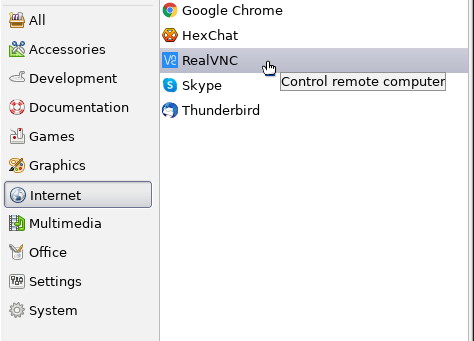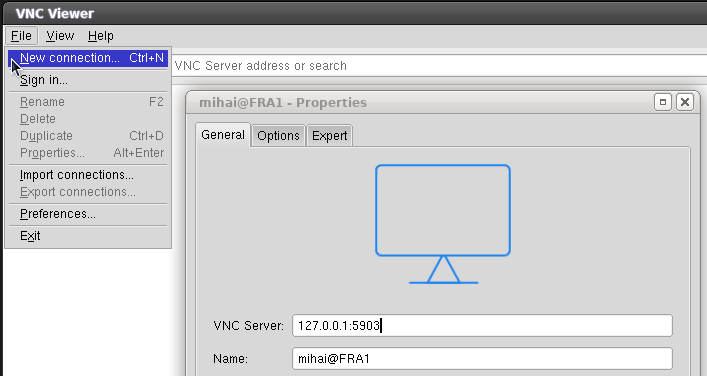Install tigervnc-server
dnf install tigervnc-server xorg-x11-fonts-Type1
Check if the selinux package was installed
dnf repoquery --requires tigervnc-server dnf repoquery --requires tigervnc-server | grep selinux dnf list installed | grep tigervnc-selinux tigervnc-selinux.noarch 1.14.1-5.el9_6 @appstream
Read now to configure and start tigervnc on rocky-9.
less /usr/share/doc/tigervnc/HOWTO.md
# Limitations
You will not be able to start a TigerVNC server for a user who is
already logged into a graphical session. Avoid running the server as the
`root` user as it's not a safe thing to do. While running the server as
the `root` should work in general, it's not recommended to do so and
there might be some things which are not working properly.
Add a user mapping
emacs /etc/tigervnc/vncserver.users :3=mihai
Configure Xvnc options
emacs /etc/tigervnc/vncserver-config-defaults securitytypes=vncauth,tlsvnc desktop=sandbox alwaysshared session=xfce # Here are some tested geometries over LAN with a 4k monitor. # Uncomment only 1 line. # geometry=1920x1200 # 50 fps # geometry=2560x1440 # 40 fps # geometry=2560x1600 # 30 fps # geometry=2880x1620 # 25 fps (good) # geometry=3840x2160 # 16 fps
Set VNC password for the user
[mihai@centos: ~]$ vncpasswd
Start tigetvnc server
systemctl enable vncserver@:3 systemctl start vncserver@:3
If the vncsession.pp policy is not loaded, the server will return this error
systemctl start vncserver@:3 Job for vncserver@:3.service failed because the control process exited with error code. See "systemctl status vncserver@:3.service" and "journalctl -xe" for details. journalctl -xe -- Unit vncserver@:3.service has begun starting up. Mar 14 16:51:25 centos-s-1vcpu-1gb-ams3-01 systemd[2154]: vncserver@:3.service: Failed to change SELinux context to system_u:system_r:vnc_session_t:s0: Operation not permitted Mar 14 16:51:25 centos-s-1vcpu-1gb-ams3-01 systemd[2154]: vncserver@:3.service: Failed at step SELINUX_CONTEXT spawning /usr/libexec/vncsession-start: Operation not permitted -- Subject: Process /usr/libexec/vncsession-start could not be executed -- Defined-By: systemd -- Support: https://support.oracle.com -- The error number returned by this process is 1. Mar 14 16:51:25 centos-s-1vcpu-1gb-ams3-01 systemd[1]: vncserver@:3.service: Control process exited, code=exited status=229 Mar 14 16:51:25 centos-s-1vcpu-1gb-ams3-01 systemd[1]: vncserver@:3.service: Failed with result 'exit-code'. -- The unit vncserver@:3.service has entered the 'failed' state with result 'exit-code'. Mar 14 16:51:25 centos-s-1vcpu-1gb-ams3-01 systemd[1]: Failed to start Remote desktop service (VNC). -- Subject: Unit vncserver@:3.service has failed -- Defined-By: systemd -- Support: https://support.oracle.com
If the selinux context is not correct the server will return the following error
journalctl -xe /SetroubleshootPrivileged.py[1364]: failed to retrieve rpm info for /var/lib/selinux/targeted/active/modules/400/vncsession SELinux is preventing (on-start) from entrypoint access on the file /usr/libexec/vncsession-start. For complete SELinux messages run: sealert -l 95553683-515b-405f-9b1a-1437e273df79 ***** Plugin restorecon (99.5 confidence) suggests ************************ If you want to fix the label. /usr/libexec/vncsession-start default label should be vnc_session_exec_t. Then you can run restorecon. The access attempt may have been stopped due to insufficient permissions to access a parent directory in which case try to change the following command accordingly. Do /sbin/restorecon -v /usr/libexec/vncsession-start
If you need to troubleshoot the selinux error, then let's first check the labels:
chcon -u system_u -t user_home_dir_t -v $HOME chcon -u system_u -r object_r -t xdm_home_t -Rv $HOME/.vnc
Check tigervnc selinux policy module
dnf repoquery --list tigervnc-selinux.noarch /usr/share/selinux/packages/targeted/vncsession.pp.bz2
Let's unpack the module and see the content
cd /tmp cp /usr/share/selinux/packages/targeted/vncsession.pp.bz2 . bzip2 -d vncsession.pp.bz2 semodule_unpackage vncsession.pp vncsession.mod sedismod vncsession.mod play with the menu: (m for the menu)
Read here about loading and unloading policies.
sestatus | grep Loaded Loaded policy name: targeted semodule -l semodule -l | grep vncsession
If vncsession.pp policy is not loaded then:
The command semodule -i
The .pp.bz2 extension indicates a policy package (pp) that has been compressed with bzip2.
cd /usr/share/selinux/packages/targeted chmod 644 vncsession.pp.bz2 semodule -i vncsession.pp.bz2 libsemanage.semanage_direct_install_info: Overriding vncsession module at lower priority 200 with module at priority 400.
VNC connection is not encrypted. We must use an ssh tunnel.
firewall-cmd --zone=public --list-all firewall-cmd --zone=public --add-service=ssh --permanent # add ssh if not added before firewall-cmd --add-port=5903/tcp --permanent # vncserver@:3 firewall-cmd --reload
If you do this on a headless server then install X11, XFCE and lightdm as on
Rocky-9.
You have to start XFCE once for the <USER> to create the default desktop.
It may be needed to reboot the server once.
Download the VNC viewer for Linux from realvnc website and install it to /opt
su mkdir -pv /opt/vnc-viewer mv VNC-Viewer-*-Linux-x64 /opt/vnc-viewer/ cp -v /home/mihai/Code/git-main/script/realvnc/vnc-viewer.png /opt/vnc-viewer chown -Rv root:root /opt/vnc-viewer chcon -Rv -u system_u -t usr_t /opt/vnc-viewer
cat > /usr/share/applications/realvnc.desktop << EOF [Desktop Entry] Name=RealVNC GenericName=VNC Viewer Comment=Control remote computer Exec=/opt/vnc-viewer/VNC-Viewer-6.19.1115-Linux-x64 Terminal=false Icon=/opt/vnc-viewer/vnc-viewer.png Type=Application Categories=Network; Version=1.0 X-Desktop-File-Install-Version=0.23 EOF
Create the ssh tunnel
ssh -L 5903:$DIGITALOCEAN:5903 -l mihai $DIGITALOCEAN
or connect using a private key
ssh -L 5903:$DIGITALOCEAN:5903 -i ~/.ssh/id_rsa_digitalocean -l mihai $DIGITALOCEAN
Start RealVNC

Add a new connection

To connect from a Windows client read
here
about How to Tunnel VNC over SSH.
You will need
PuTTY and
RealVNC for this.
PUTTYGEN -> Menu -> Conversions -> Import key -> Save private key with .ppk extension.
See which VNC port is currently open
nmap localhost PORT STATE SERVICE 22/tcp open ssh 25/tcp open smtp 5903/tcp open vnc-3 6003/tcp open X11:3